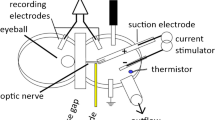Summary
A frequency of 5300 Å, derived from a frequency-doubled Q-switched neodymium laser was observed to produce progressive injury and death of cells from a culture of newborn rat cerebellum. A subsequent observation that the green laser frequency (but not 6943 Å of the same intensity from a Q-switched ruby laser) could reduce the rate of oxygen consumption of rat brain cell suspensions suggested that the cytochromes may serve as chromophores. This hypothesis was confirmed by a demonstration that cytochromes c+c1 failed to act as hydrogen acceptors following 10 impacts of 1 Mw/cm2 each of the green laser frequency and cytochromes a+a3 showed a similar response when a brain cell suspension was irradiated (200 kw) with frequencies of 6096 and 6013 Å. These data illustrate the principle that laser frequencies which are appropriately matched to the absorption characteristics of target molecules can selectively inhibit specific molecular components in intact cells, if a controlled energy density range is used.
Similar content being viewed by others
References
Amy, R. L., and R. Storb: Selective mitochondrial damage by a ruby laser microbeam using Janus green as a vital specific dye absorbent. Science 150, 756–758 (1965).
Chance, B.: Electron transfer in biological systems. Proc. I. R. E. 47, 1821–1840 (1959).
—, and B. Hess: Spectroscopic evidence of metabolic control. Science 129, 700–708 (1959).
Derr, V. W., E. Klein, and S. Fine: Free radical occurrence in some laser-irradiated biological materials. Fed. Proc. 24, Suppl. 14, S99-S103 (1965).
Eckhardt, G., R. W. Hellwarth, F. J. McLung, S. E. Schwarz, D. Weiner, and E. J. Woodbury: Stimulated Raman scattering from organic liquids. Phys. Rev. Letters 9, 455 (1962).
El-Sayed, M., F. M. Johnson, and J. A. Duardo: Stimulated Raman scattering of 6943 Å and 5289 Å laser radiation. J. Chim. phys. (France), No 1, 227–234 (1967).
Franken, P. A., and J. F. Ward: Optical harmonics and non-linear phenomena. Rev. Mod. Phys. 35, 23 (1963).
Garmire, E., F. Pandarese, and C. H. Townes: Coherently driven molecular vibrations and light modulation. Phys. Rev. Letters 11, 160 (1963).
Jobsis, F. F.: In: Handbook of Physiology, Section 3, Respiration 1, Amer. Physiol. Soc. (1964), Washington, D.C.
Johnson, F. M.: Quadruple frequency multiplication of a 1.06 μ neodymium-pulsed laser. Nature (Lond.) 204, 985–987 (1964).
—, R. Olson, and D. E. Rounds: Effects of high-power green laser radiation on cells in tissue culture. Nature (Lond.) 205, 721–722 (1965).
Mendelson, J. A., and N. B. Ackerman: Studies of biologically significant forces following laser irradiation. Fed. Proc. 24, Suppl. 14, S111-S115 (1965).
Minck, R. W., R. W. Terhune, and W. G. Rado: Laser-stimulated Raman effect and resonant four-photon interactions in gases, H4, D2, Ch4. Appl. Phys. Letters 3, 181 (1963).
Minton, J. P., M. Zelen, and A. Ketcham: Some factors affecting tumor response after laser radiation. Fed. Proc. 24, Suppl. 14, S155-S158 (1965a).
— Experimental results from exposure of Cloudman S-91 melanoma in the CDBA/2F hybrid mouse to neodymium or ruby laser radiation. Ann. N.Y. Acad. Sci. 122, 758–766 (1965b).
Rounds, D. E., E. C. Chamberlain, and T. Okigaki: Laser radiation of tissue cultures. Ann. N.Y. Acad. Sci. 122, 713–727 (1965).
—, and R. S. Olson: The effect of intense visible light on cellular respiration. Life Sci. 6, 359–366 (1967).
—, and F. M. Johnson: The laser as a potential tool for cell research. J. Cell Biol. 27, 191–197 (1965).
Author information
Authors and Affiliations
Additional information
This work was supported in part by the U.S. Army Medical Research and Development Command, Office of the Surgeon General, under Contract No. DA-49-193-MD-2564, and in part by Electro-Optical Systems, Inc.
Rights and permissions
About this article
Cite this article
Rounds, D.E., Olson, R.S. & Johnson, F.M. The effect of the laser on cellular respiration. Z. Zellforsch. 87, 193–198 (1968). https://doi.org/10.1007/BF00319718
Received:
Issue Date:
DOI: https://doi.org/10.1007/BF00319718




